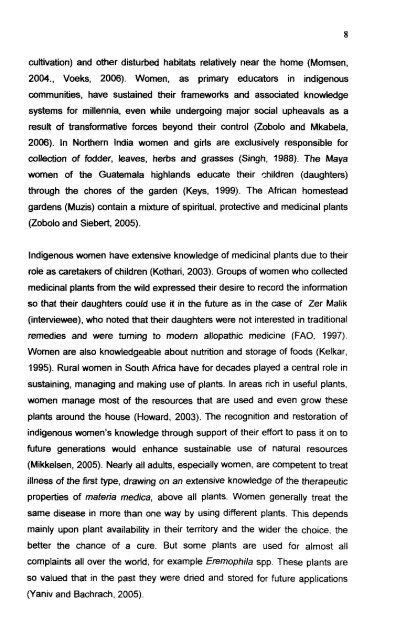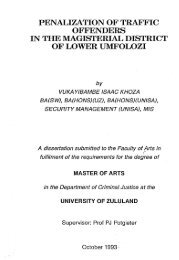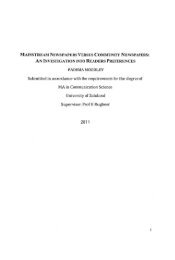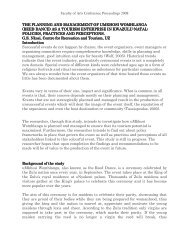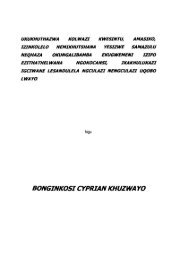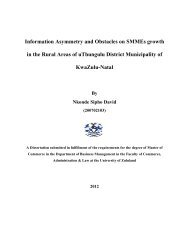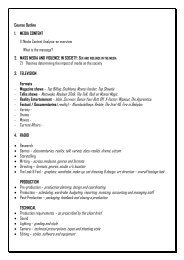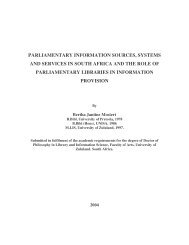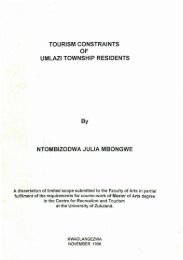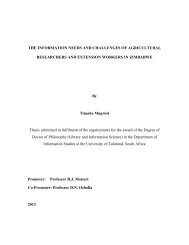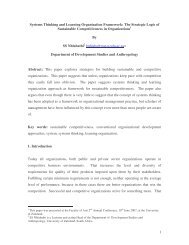The screening of medicinal plants traditionally used to treat ...
The screening of medicinal plants traditionally used to treat ...
The screening of medicinal plants traditionally used to treat ...
- No tags were found...
You also want an ePaper? Increase the reach of your titles
YUMPU automatically turns print PDFs into web optimized ePapers that Google loves.
8cultivation) and other disturbed habitats relatively near the home (Momsen,2004., Voeks, 2006). Women, as primary educa<strong>to</strong>rs in indigenouscommunities, have sustained their frameworks and associated knowledgesystems for millennia, even while undergoing major social upheavals as aresult <strong>of</strong> transformative forces beyond their control (Zobolo and Mkabela,2006). In Northern India women and girls are exclusively responsible forcollection <strong>of</strong> fodder, leaves, herbs and grasses (Singh, 1988). <strong>The</strong> Mayawomen <strong>of</strong> the Guatemala highlands educate their -::hildren (daughters)through the chores <strong>of</strong> the garden (Keys, 1999). <strong>The</strong> African homesteadgardens (Muzis) contain a mixture <strong>of</strong> spiritual, protective and <strong>medicinal</strong> <strong>plants</strong>(Zobolo and Siebert, 2005).Indigenous women have extensive knowledge <strong>of</strong> <strong>medicinal</strong> <strong>plants</strong> due <strong>to</strong> theirrole as caretakers <strong>of</strong> children (Kothari, 2003). Groups <strong>of</strong> women who collected<strong>medicinal</strong> <strong>plants</strong> from the wild expressed their desire <strong>to</strong> record the informationso that their daughters could use it in the future as in the case <strong>of</strong> Zer Malik(interviewee), who noted that their daughters were not interested in traditionalremedies and were turning <strong>to</strong> modem allopathic medicine (FAO, 1997).Women are also knowledgeable about nutrition and s<strong>to</strong>rage <strong>of</strong> foods (Kelkar,1995). Rural women in South Africa have for decades played a central role insustaining, managing and making use <strong>of</strong> <strong>plants</strong>. In areas rich in useful <strong>plants</strong>,women manage most <strong>of</strong> the resources that are <strong>used</strong> and even grow these<strong>plants</strong> around the house (Howard, 2003). <strong>The</strong> recognition and res<strong>to</strong>ration <strong>of</strong>indigenous women's knowledge through support <strong>of</strong> their effort <strong>to</strong> pass it on <strong>to</strong>Mure generations would enhance sustainable use <strong>of</strong> natural resources(Mikkelsen, 2005). Nearly all adults, especially women, are competent <strong>to</strong> <strong>treat</strong>illness <strong>of</strong> the first type, drawing on an extensive knowledge <strong>of</strong> the therapeuticproperties <strong>of</strong> materia medica, above all <strong>plants</strong>. Women generally <strong>treat</strong> thesame disease in more than one way by using different <strong>plants</strong>. This dependsmainly upon plant availability in their terri<strong>to</strong>ry and the wider the choice, thebetter the chance <strong>of</strong> a cure. But some <strong>plants</strong> are <strong>used</strong> for almost allcomplaints all over the world, for example Eremophila spp. <strong>The</strong>se <strong>plants</strong> areso valued that in the past they were dried and s<strong>to</strong>red for future applications(yanivand Bachrach, 2005).


